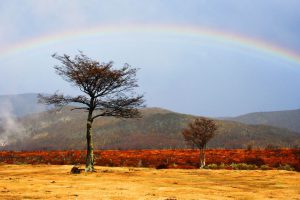One highlight of any expedition cruise to Patagonia is wildlife-watching. South America’s best-known beast is probably the camel-like llama, but that’s a domestic animal most common in the central Andean countries of Ecuador, Peru and Bolivia. In Patagonia, though, the rangy wild guanaco – a close relative to the llama – is a common sight as it bounds across the steppe and over fences that stop short-legged sheep in their tracks.
By contrast, the Andean deer or huemul (pronounced “way-mool”) is a rarer mammal that grazes the edge of the forest and, so, it is less easily sighted. With a stockier body and shorter legs than the guanaco, it can navigate rugged terrain more easily. Easily distinguished by their antlers, bucks are only slightly larger than the does.

The huemul occurs in both Argentina and Chile but, in Chile, it is officially a “national monument.” That designation usually applies to an architectural or natural landmark, or a relatively small area of protected land, but it can also apply to “regions, objects or living species of plants or animals of aesthetic, historic or scientific interest.”
In southernmost Patagonia, sighting a huemul is something special. There are probably only a couple dozen or so in Parque Nacional Torres del Paine, and a few dozen more in the adjacent Parque Nacional Bernardo O’Higgins – which is far less accessible. I’ve seen them alongside the roadside, though, in thinly populated parts of the Aisén region, in more northerly Chilean Patagonia, where they readily cooperated with my photographic efforts.

The huemul is also an important symbol as part of Chile’s coat-of-arms. There it appears on either side of the lone star (no relation to Texas) with the Andean condor and the motto “Por La Fuerza o La Razón” (“By Might or Right” or – translated more gently – “By Strength or Reason”).
No comments yet
There are no comments on this post yet.






Leave a comment